Painted in Mexico, Visual Voyages: Images of Latin American Nature, and Modern Masters from Latin America
Painted in Mexico, 1700–1790: Pinxit Mexici
Curated by: Ilona Katzew with Jamie Cuadriello, Paula Mues Orts, and Luisa Elena Alcala
Exhibition schedule: Palacio de Cultura Citibanamex-Palacio de Iturbide (Fomento Cultural Banamex, A.C.), Mexico City, June 29–October 15, 2017; Los Angeles County Museum of Art, November 19, 2017–March 18, 2018; The Metropolitan Museum of Art, New York, April 24–July 22, 2018
Exhibition catalogue: Ilona Katzew, ed., with contributions by Luisa Elena Alcala, Jaime Cuadriello, Paula Mues Orts, and Ronda Kasl. Painted in Mexico, 1700–1790: Pinxit Mexici, exh. cat. Los Angeles County Museum of Art and Fomento Cultural Banamex, A.C., and Delmonico Books, Prestel, 2017. 512 pp.; 409 color illus., 14 b/w illus. Hardcover $85.00 (9783791356778)
Visual Voyages: Images of Latin American Nature from Columbus to Darwin
Curated by: Daniela Bleichmar and Catherine Hess
Exhibition schedule: The Huntington Library, San Marino, California, September 16, 2017–January 8, 2018
Exhibition catalogue: Daniela Bleichmar, Visual Voyages: Images of Latin American Nature from Columbus to Darwin, exh. cat. Yale University Press in association with The Huntington, 2017. 240 pp.; 153 color illus. Hardcover $50.00 (9780300224023)
Modern Masters from Latin America: The Pérez Simón Collection
Curated by: Roxana Velásquez Martínez del Campo
Exhibition schedule: San Diego Museum of Art, October 21, 2017–March 11, 2018
Exhibition catalogue: Roxana Velásquez Martínez del Campo, ed., with essays by Rocio G. Guerrero Mondono and Gerardo Mosquera, Modern Masters from Latin America: The Pérez Simón Collection, exh. cat. San Diego: The San Diego Museum of Art with Ediciones El Viso, Madrid, 2017. 208 pp.; 140 color illus. Hardcover $45.00 (9780937108574)
From September 2017 to January 2018, Pacific Standard Time: LA/LA, the sprawling and ambitious exploration of Latin American and Latinx art in dialogue with Los Angeles, dominated art institutions across Southern California. Made possible by a multimillion-dollar grant from the Getty Foundation, LA/LA was the third in the Pacific Standard Time program since 2011 and has generated more than 150 exhibitions of art and architecture across Southern California. In December of 2017, I made a pilgrimage from snowy, gray Philadelphia to the blue skies and palm trees of Southern California. Much more than an escape from the wintry East Coast, this was a once-in-a-lifetime opportunity to see a group of exhibitions with art assembled from across the Americas that helped ask and answer questions about centuries of artistic interaction between the United States and Latin America. It is no accident that this series of exhibitions happened in and around Los Angeles; indeed, it is possible that this matrix of projects could not have happened anywhere else. While there are other cities in the US that were once part of Mexico, and before that viceregal New Spain—as well as cities with large Latin American populations—the presence of the Getty Foundation, the sheer number of museums, the global influence of Hollywood, and the vibrant immigrant communities of southern California create a fertile ground for creative explorations of Latin American art unparalleled elsewhere in the country.
At the beginning of this review, I bring up palm trees and colors consciously, as the three exhibitions considered here are filled with a tropical lushness—not only in the spectacular variety of works of art included, but also in the rich colors used in the design of the exhibitions and the explosion of curatorial knowledge in the handsome and vibrant exhibition catalogues. The afternoon I arrived in LA, I drove straight to the Los Angeles County Museum of Art (LACMA) and visited the galleries of Painted in Mexico as dusk was settling over the mountains that rim the city. Upon entering, I did not know which way to turn—the galleries of the Resnick Pavilion at LACMA were filled with a number of exhibitions, and as a result, wayfinding was not entirely self-evident. I was soon arrested by the sight of five jewel-like allegorical paintings from Mexico City hung on a canary-colored wall, with seven of the iconic Los Angeles palm trees rising behind them, visible through the scrimmed glass sheath of the pavilion (fig. 1).
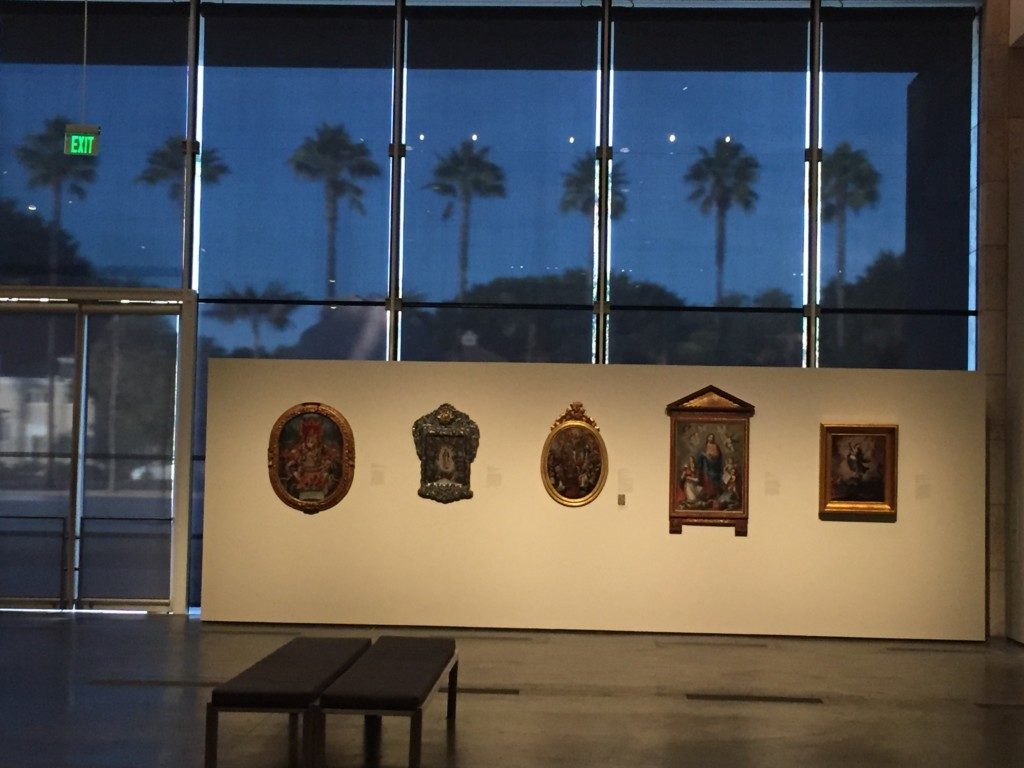
Painted in Mexico: 1700–1790 includes more than one hundred paintings and is divided into seven sections—Great Masters, Master Story Tellers and the Art of Expression, Noble Pursuits and the Academy, Paintings of the Land, The Power of Portraiture, The Allegorical World, and Imagining the Sacred. The art in this exhibition is so spectacular, and the scholarship evident in the catalogue so remarkable, that this review will place criticism of the installation at LACMA in the foreground, so the rest of this review will examine what is exemplary about the exhibition. As previously mentioned, the Resnick building at LACMA is not the ideal place to experience an exhibition. Next to the Painted in Mexico exhibition was Chagall: Fantasies for the Stage, and the music from that exhibition filtered into the Mexican painting show in the most distracting way. In addition to the sonic dissonance, the space was awkwardly carved up, making it hard to know which section to go to next. Luckily the themes did have some overlap and interaction, which encouraged visitors to wander at will and simply enjoy the luscious paintings. Likewise, I began to ignore most of the labels—not because they were not well written or filled with excellent information, but because their length was overwhelming. The introductory texts for each section were two to three paragraphs long, and studies indicate visitors will not read more than one. The individual object labels seemed to average about five sentences, as compared to three sentences at the Visual Voyages exhibition at The Huntington, which I found to be much more user-friendly and did not lead to as much label fatigue.
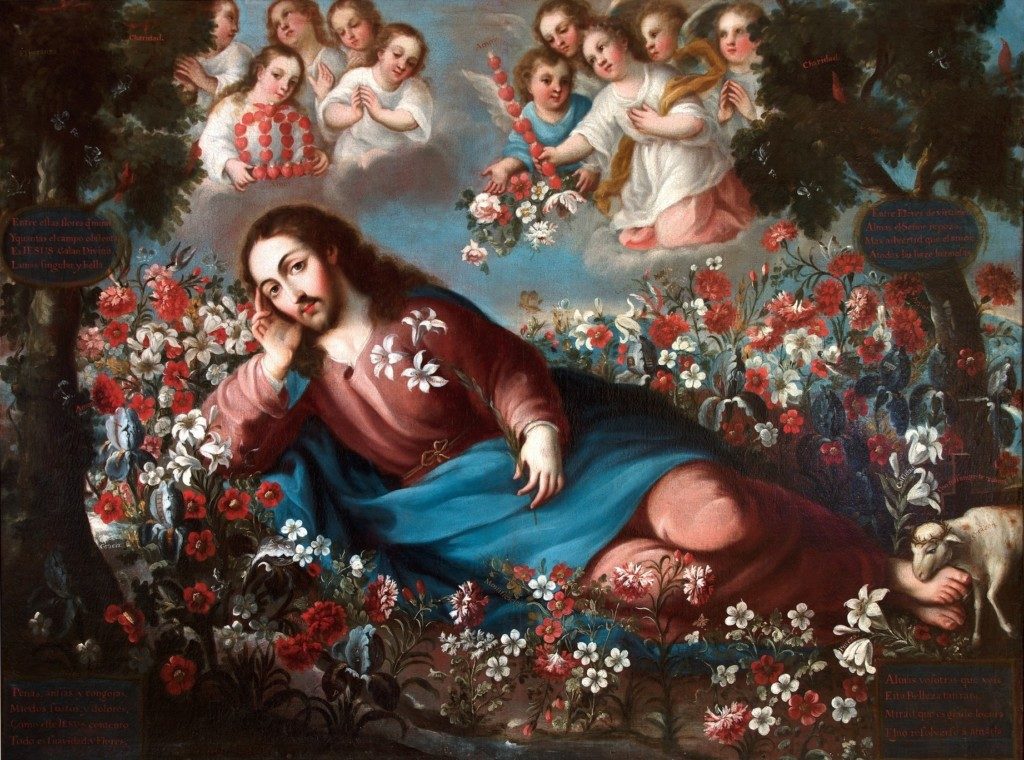
As a curator of art of the United States and a lover of Spanish colonial art, I was able to let the labels go, knowing as I did that I would later read the catalogue, tune out the noise, and just enjoy the art. It is a triumph of curatorial negotiation and fundraising acumen that this many masterworks from Mexico and Spain were able to make their way to not just one, but two venues in the United States. Even if one is lucky enough to travel to Mexico City and Madrid, it would be challenging, if not impossible, to see many of the works in this exhibition. But one example by Miguel Cabrera (c.1715–1768), the sublimely sexy The Divine Spouse (c.1750; fig. 2), I was lucky enough to see in a Mexico City bedroom in 2016. This painting was one of many by the supremely talented Cabrera, and it should be a revelation to audiences in the United States unfamiliar with the art of colonial Mexico. The subject of Christ, the titular Divine Spouse, reclining in a lush mystical garden is as appealing to the viewer today as it must have been to the cloistered nuns for whom it was meant to inspire divine virtue in the eighteenth century. The painting was hung in the Allegorical World section of the exhibition but could have hung comfortably in the Imagining the Sacred area or the Great Master section.
Another spectacular painting by Cabrera, Portrait of María Bárbara Guadalupe de Ovando y Rivadeneyra with Guardian Angel (c. 1760), in The Power of Portraiture section of the exhibition, is also from a private collection. This portrait of a wealthy woman from Puebla was likely commissioned following her second marriage. Behind the sitter, taking up two thirds of the canvas, is her guardian angel. The painting is both portrait and devotional image, a categorical elision that was as commonplace in mid-eighteenth century Mexico City as it was in Flanders or Italy during the Renaissance, but utterly distinct from what Anglo-American Protestant painters were doing in the British colonies in the same time period. It behooves scholars of American art to consider this when teaching and curating exhibitions that examine “American” art in the eighteenth century. Most fascinating about these two paintings by Cabrera is that, in addition to being beautifully painted, sumptuous images, they act as windows into the spiritual lives of both sacred and profane women in mid-eighteenth century Mexico.
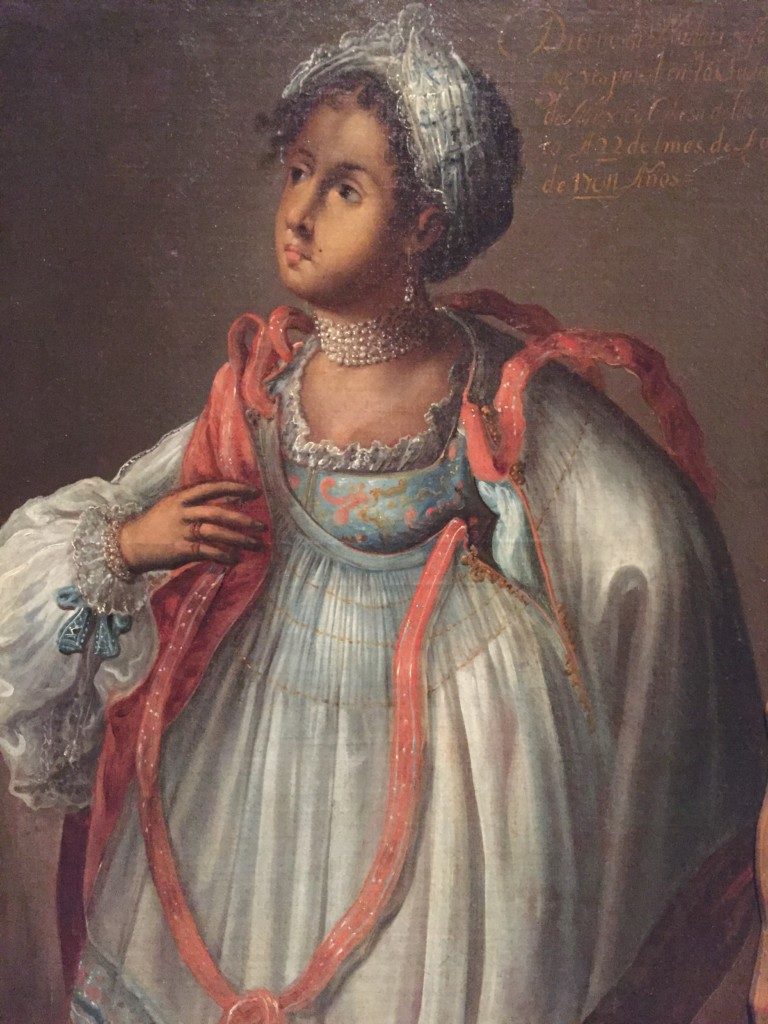
Another revelation of the exhibition is the oil-on-copper devotional paintings included in the section Imagining the Sacred. It was these small paintings that were so arresting in the installation of the exhibition at LACMA. I loved the intimacy and the fine detail of these paintings. Details, in particular flowers and divine light, glowed on the copper, and the only comparable art I could relate this to would be illuminated manuscripts painted on vellum. Other sections of the exhibition were less surprising, such as the section that includes casta paintings. These paintings were included in the section Paintings of the Land, which at first seems a somewhat incongruous title, given that the paintings are mostly of people. However, the exhibition text makes clear that “paintings of the land” (pinturas de la tierra) refer to work made in Mexico depicting local subjects. Casta painting may be familiar to many scholars of American art through various recent excellent publications, including Ilona Katzew’s Casta Painting: Images of Race in Eighteenth-Century Mexico (2005) and Race and Classification: The Case of Mexican America (2009).1 Two works in particular stood out to me in this section, Morisca Woman and Albino Girl (c.1750; LACMA), by an unknown artist, and Manuel de Arellano (1662–1722), Rendering of a Mulatta (1711; fig. 3), from the Denver Art Museum, one of the great US collections of Spanish colonial art. These two paintings are clearly portraits of individuals, even though they are part of the casta genre—a type of painting that categorized and ranked racial groups in New Spain. Yet, just like the sitters in the portraiture section of the exhibition, these women have no names that have come down to us. The absence of names makes the paintings no less compelling or individual, but I found myself wishing that we knew more about these women and their British colonial sisters of same time period.
The catalogue is a landmark of scholarship and was deservedly listed by the New York Times as one of the best art books of 2017. The book is divided into two sections. The first is a series of thematic essays—“Painted in Mexico, 1700–1790: Pinxit Mexici,” by Luisa Elena Alcala, Jaime Cuadriello, Ilona Katzew, and Paula Mues Orts; “Illustrious Painting and Modern Brushes: Tradition and Innovation in New Spain,” by Paula Mues Orts; “The Radiating Image: The Mobility of Painting in Eighteenth-Century Mexico,” by Ilona Katzew; and “The Politicization and Sociability of the Public Image: The King and His Representatives, 1700–1790” and “Mexican Painting in the Age of Ornamentation,” by Luisa Elena Alcala. Following these essays are 139 illustrated catalogue entries. The scholarly heft of the publication is one that is rarely afforded to exhibition catalogues these days and will immediately make this catalogue essential reading for students of eighteenth-century Mexican painting. The scholarly focus of the catalogue is important to note in an age of slimmer museum publications, as is the inclusion of thematic essays and the excellent connoisseurship in the tradition of European Old Master scholarship. The curators’ educated eyes are in evidence throughout the publication, and we the readers are given the benefit of decades of close and personal observation.

Visual Voyages: Images of Latin American Nature from Columbus to Darwin (fig. 4) presents more than 150 paintings, rare books, illustrated manuscripts, prints, and drawings from The Huntington’s holdings as well as from collections around the world, many of which are on view for the first time in the United States. The exhibition examines the period between Christopher Columbus’s first voyage in 1492 and Charles Darwin’s publication of On the Origin of Species in 1859. Despite the Boone gallery’s spatial limitations, the designers, Chu + Gooding Architects of Los Angeles, open the exhibition in a striking way, with gridded display cases of specimens and rare materials, as well as a taxidermy armadillo that visitors are invited to touch. Outside the gallery, The Huntington complements the exhibition design in a way only they can, with stunning “visual voyages” installations in the gardens, including cacao, pineapple, tobacco, and other plants indigenous to Latin America. This focus on indigeneity continues in the body of the exhibition itself.
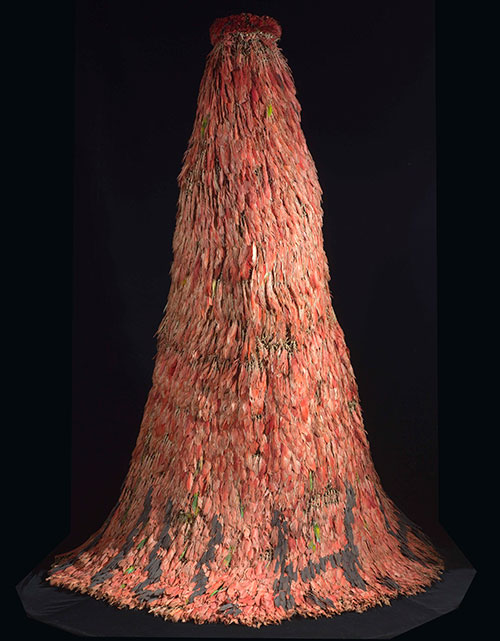
Upon entering the exhibition, visitors are stopped in their tracks by the presence of a spectacular feather cape created by the Tupinambá of Brazil in the seventeenth century, on loan to The Huntington from the Musées Royaux d’Art et d’Histoire, Brussels (fig. 5). Seeing this rare object took my breath away. I am familiar with equally spectacular, but much smaller, feather work mosaics made in Mexico, which, like this cape, often ended up in European collections. But I have never seen such a large and immaculate example of American feather work in the United States. The loan of this cape embodies two of the aspects of this exhibition that are most remarkable: the exhibition enables Southern Californians to see objects that have never before been in the United States, therefore expanding dramatically their understanding of the historic arts of North and South America; and the exhibition privileges indigenous knowledge and artistic production, displaying objects such as the cape on equal footing with objects made by artists of European descent working in the Americas. This object is an excellent start for an exhibition, that, according to The Huntington’s press release, “looks at how indigenous peoples, Europeans, Spanish Americans, and individuals of mixed-race descent depicted natural phenomena for a range of purposes and from a variety of perspectives: artistic, cultural, religious, commercial, medical, and scientific.”
The exhibition is divided into four sections—Rewriting the Book of Nature, The Value of Nature, Collecting: From Wonder to Order, and New Landscapes. The first section focuses on an area of collecting strength for The Huntington: rare manuscripts, maps, and books that focus on New World flora and fauna, both from European and indigenous perspectives. This review begins by situating itself within palm trees, color, and the tropics. Nowhere is this more on display than in the rare manuscripts and books in the exhibition, which are alive with fecundity and color—an aspect enhanced by the exhibition designers, who use details from these works on paper blown up beautifully on vinyl wall panels. Included in this section is a 1493 letter from Christopher Columbus, who wrote to the King and Queen of Spain that the New World was “so fertile that, even if I could describe it, one would have difficulty believing in its existence.” That fertility is in evidence throughout the exhibition, particularly in the second section of the exhibition, the Value of Nature, with works on paper showing New World flora—nopal, tobacco, chocolate, cochineal, and passionflowers. The first two sections of the show also include a large number of post-contact hybrid objects—two stunning full-color maps painted by indigenous artists in Mexico and Guatemala and a volume from the Florentine Codex, a sixteenth-century Mexican manuscript famous for its melding of indigenous and European painting styles and subject matter. The fact that these objects are together in the exhibition is remarkable, as most students of this early Mexican material in the United States can only access such works digitally or in printed reproductions. The exhibition is a rare opportunity to see them in all their precious brilliance.
The central section of the exhibition, Collecting, From Wonder to Order, traces the period in Europe from cabinets of curiosities to enlightenment taxonomies, with the visual arts as embodiment of these visual systems. Two stunning walls dominate this section of the exhibition. The first is a grouping of four paintings of tropical fruits, on loan from the National Museum of Denmark, painted in Brazil in the 1640s by the Dutch artist Albert Eckhout (c. 1610–1666). The second is a remarkable wall of twenty vibrant tempera-on-paper paintings of botanical specimens painted by artists from New Granada (present-day Colombia, Ecuador, Panama, Venezuela, Peru, northern Brazil, and western Guyana) between 1783 and 1816, from the collection of the Jardin Botanico in Madrid and never before seen in the United States. The vibrancy of these fragile works is amazing, and you can see the pride the artists took in completing their commissions from the Royal Expedition to New Granada in their signature, which reads “Americanus pinxit,” roughly translated to “made in America,” or “painted by an American.”
The final section of the exhibition, New Landscapes, is unfortunately also the weakest, in the opinion of this reviewer. Perhaps this criticism stems from knowledge of the vast scholarship on nineteenth-century landscape painting in the Americas, including the recent 2015 exhibition and catalogue Picturing the Americas: Landscape Painting from Tierra del Fuego to the Arctic.2 Although the objects were all well chosen, the emphasis on Alexander von Humboldt, Charles Darwin, modern independence movements, and landscape painting was just too much for this small space, especially since each of these topics could merit its own exhibition; indeed, the Smithsonian American Art Museum is currently working on one on Humboldt and American art. Perhaps it is also the fault of the architectural space of the gallery and a failure of exhibition design that contributes to this feeling. The two panoramic landscape paintings—Chimborazo (1864) by Frederic Edwin Church (1826–1900) from The Huntington (fig. 6) and Valley of Mexico (1877) by Mexican painter José María Velasco (1840–1912), on loan from the Museo Nacional de Arte in Mexico City—are meant to end the exhibition on a spectacular “wow”—but they are interrupted by the doorway leading out of the gallery, and a huge case with only two catalogues in it dominates the space of this final section.

While New Landscapes was a disappointing end to a spectacular exhibition, luckily this experience is not replicated in the scholarly and lavishly illustrated catalogue. Written by co-curator Daniela Bleichmar, associate professor of art history at the University of Southern California, the catalogue is a must-read for those interested in the intersection of art and science, exploration, collecting, modes of European and indigenous natural history and mapmaking, and the interconnections within the art histories of Brazil, Mexico, and the United States from the age of exploration to the mid-nineteenth century. The chapters are divided in the same way as the themes of the exhibition, with no catalogue entries but excellent narrative essays about the objects in the show.
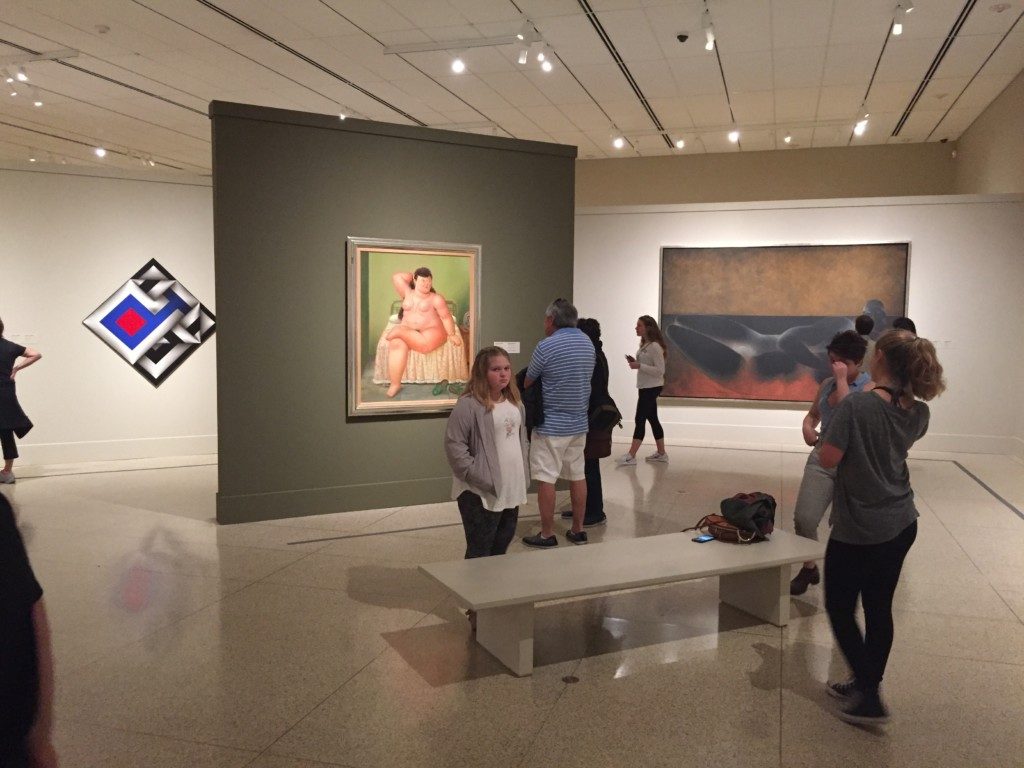
Modern Masters from Latin America: The Pérez Simón Collection (fig. 7) at the San Diego Museum of Art (SDMA) includes ninety-nine works of art from the private collection of Pérez Simón and is arranged in three sections: Landscape and Identity, The Avant-Garde Explosion, and Breaking Boundaries: Post-1960s Diversity and Dystopia. Although the majority of the works date from the twentieth century, the exhibition does open, somewhat incongruously, with two beautiful nineteenth-century paintings of the Valley of Mexico by José María Velasco. The paintings, as fine as they are, serve as something of a foil to the modern landscapes that follow after them, such as the work by Rufino Tamayo (1899–1991), Clear Night (1932; fig. 8). In a foreword to the catalogue, the collector specifically states that this exhibition focuses on twentieth-century artists from Latin America. However, the collection itself is much larger than that material, as the inclusion of the Velascos suggests. A perusal of the checklist for Painted in Mexico at LACMA, for example, reveals that the collector lent numerous works to that exhibition as well.

The twentieth-century works that form the bulk of the exhibition are strong and varied and include the work of influential artists from Argentina, Chile, Colombia, Cuba, Mexico, Peru, Brazil, and Uruguay. The artists featured include those who will be both familiar and new to scholars of art of the United States, including Fernando Botero, Félix González-Torres, Frida Kahlo, Wifredo Lam, Roberto Matta, José Clemente Orozco, Alfredo Ramos Martínez, Diego Rivera, David Alfaro Siqueiros, Jesús Rafael Soto, and Tamayo. Two artists whose work may be unfamiliar to many scholars of art of the United States are represented by two spectacular works, one by Brazilian Candido Portinari
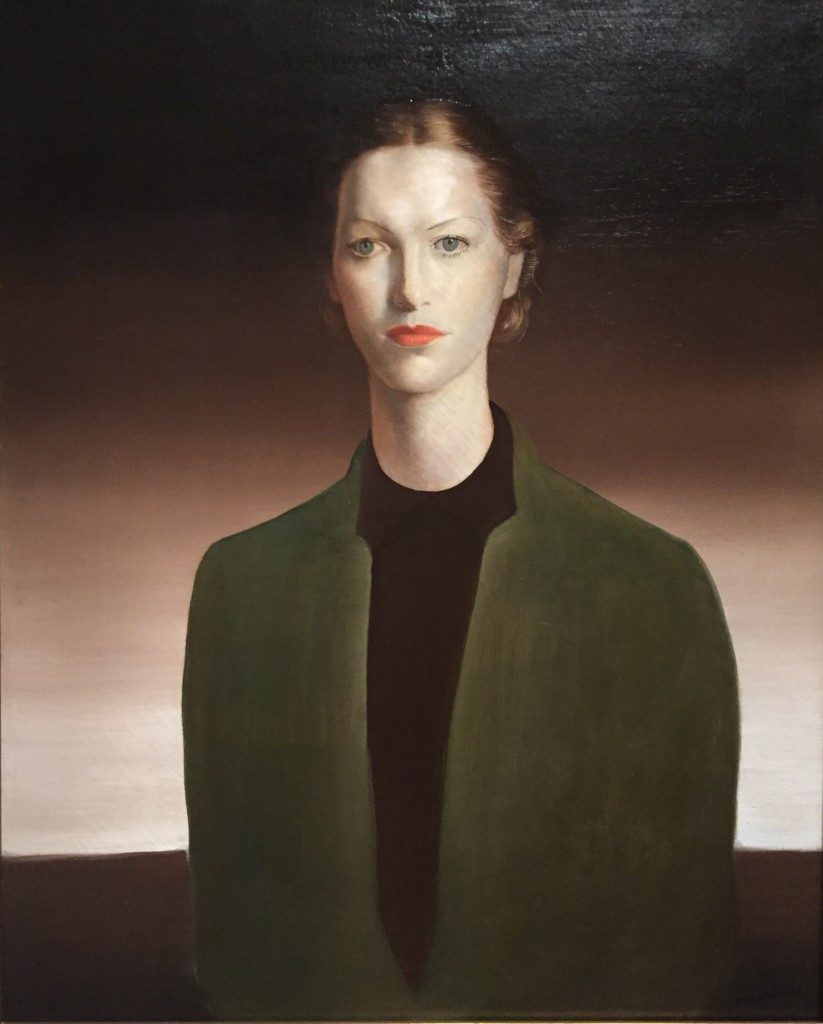
(1903–1962), Portrait of Joanita Blank (c.1937; fig. 9), and another by Mexican Emilio Baz Viaud (1918–1991), Portrait of Silvia (1943). These two portraits remain lodged in my mind, and they merit expanded dialogue with works by US regionalists and modernists of the 1930s and 1940s, such as Isabel Bishop and Luigi Lucioni. These Brazilian, Mexican, and American (US) artists were looking to archaic painting styles and techniques to craft a new modernism for their countries. In my own scholarship, I have been looking at nineteenth-century academic artists from these same three countries who work in the genre of history painting. Seeing these modernist paintings has made me realize how much fruitful scholarship remains to be done, building on existing excellent scholarship, to further understand connections between modernists in the United States and Mexico. Scholars of art of the United States rarely have the funds or encouragement to travel broadly beyond Europe in order to think comparatively or hemispherically about American art. Exhibitions such as Modern Masters from Latin America encourage visitors to think this way about Latin American art. I would argue that more exhibitions of historic art of the United States should initiate similar work.
In the catalogue, the themes from the exhibition are further broken down. The landscape section is divided into National Identity, and New Worlds; The Avant-Garde Explosion into the Latin American Diaspora and Urban Iconography; and Breaking Boundaries: Post-1960s Diversity and Dystopia into Ruptures and Transgressions. If these divisions seem to the reader somewhat generic, and applicable to all manner of art of the twentieth century, then that may prove the challenge of organizing an exhibition based on a private collection. The story of the exhibition is really the story of one individual’s taste: what appeals to him and what does not, what subject matter is of interest and what is not. While at the same time the collection does offer a snapshot of the broader trends in the art of Latin America, the show lacks the cohesive narrative upon which the other exhibitions included in this review are built.
In conclusion, returning to the framework of tropical lushness with which I began, visiting Modern Masters from Latin America at the SDMA was a combination of visual and spatial incongruities. The SDMA is set in the lush confines of Balboa Park—named for the Spanish maritime explorer Vasco Núñez de Balboa and developed in 1915 and 1916 as the home for the Panama-California Exposition—and is a National Historic Landmark built in the Spanish Colonial Revival style. Surrounding the museum is a fantasy of Spanish Colonial gardens and fountains; however, the majority of the objects in this show reflect the hard-edge styles of international modernism and postwar abstraction. While many Latin American modernists reference the tropics in their works—I am thinking, for example, of the work of Brazilian modernist Tarsila do Amaral (1886–1973)—this was not the kind of work included in the exhibition. And yet, the lure of explosive color and the tropical landscape was not entirely absent. The cover image chosen for the catalogue was Gerardo Murillo (Dr. Atl) (1875–1964), The Eruption of Paricutin (c. 1943)—a subject that, although it was painted in Mexico in a modernist style, would make an excellent pendant to Church’s Chimborazo, which closed out Visual Voyages at The Huntington.
Cite this article: Anna O. Marley, review of Painted in Mexico (Los Angeles County Museum of Art), Visual Voyages: Images of Latin American Nature (The Huntington Library), and Modern Masters from Latin America (San Diego Museum of Art), Panorama: Journal of the Association of Historians of American Art 4, no. 1 (Spring 2018), https://doi.org/10.24926/24716839.1652.
Notes
- Ilona Katzew, Casta Painting: Images of Race in Eighteenth-Century Mexico (New Haven: Yale University Press, 2005); and Katzew, Race and Classification: The Case of Mexican America (Palo Alto: Stanford University Press, 2009). ↵
- Peter John Brownlee, Valéria Piccoli, and Georgiana Uhlyarik, eds., Picturing the Americas: Landscape Painting from Tierra del Fuego to the Arctic, exh. cat. (Toronto: Art Gallery of Ontario in association with Yale University Press, 2015). ↵
About the Author(s): Anna O. Marley is Curator of Historical American Art and Director for the Center for the Study of the American Artist at the Pennsylvania Academy of the Fine Arts.

